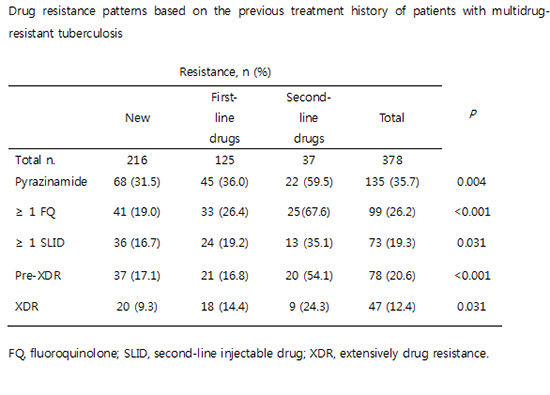1. World Health Organization. Global Tuberculosis Report 2015. 20th ed. Geneva: World Health Organization;2015.
2. Yuen CM, Kurbatova EV, Tupasi T, Caoili JC, Van Der Walt M, Kvasnovsky C, Yagui M, Bayona J, Contreras C, Leimane V, et al. Association between regimen composition and treatment response in patients with multidrug-resistant tuberculosis: a prospective cohort study. PLoS Med. 2015; 12:e1001932.
3. Monedero I, Caminero JA, Bhavaraju R, Sanchez-Montalva A. The changing landscape in drug resistant-tuberculosis: an analysis of recent advances. Expert Rev Respir Med. 2016; 10:603–606.
4. Aung KJ, Van Deun A, Declercq E, Sarker MR, Das PK, Hossain MA, Rieder HL. Successful ‘9-month Bangladesh regimen’ for multidrug-resistant tuberculosis among over 500 consecutive patients. Int J Tuberc Lung Dis. 2014; 18:1180–1187.
5. Kuaban C, Noeske J, Rieder HL, Aït-Khaled N, Abena Foe JL, Trébucq A. High effectiveness of a 12-month regimen for MDR-TB patients in Cameroon. Int J Tuberc Lung Dis. 2015; 19:517–524.
6. Piubello A, Harouna SH, Souleymane MB, Boukary I, Morou S, Daouda M, Hanki Y, Van Deun A. High cure rate with standardised short-course multidrug-resistant tuberculosis treatment in Niger: no relapses. Int J Tuberc Lung Dis. 2014; 18:1188–1194.
7. World Health Organization. WHO Treatment Guidelines for Drug-resistant Tuberculosis 2016 Update. Geneva: World Health Organization;2016.
8. Günther G, van Leth F, Altet N, Dedicoat M, Duarte R, Gualano G, Kunst H, Muylle I, Spinu V, Tiberi S, TBNET, et al. Beyond multidrug-resistant tuberculosis in Europe: a TBNET study. Int J Tuberc Lung Dis. 2015; 19:1524–1527.
9. Stagg HR, Brown J, Ibraim E, Riekstiņa V, Viiklepp P, Cīrule A, Cocei H, Danilovitš M, Dravniece G, Jackson C, et al. Drug susceptibility patterns in MDR-TB patients: challenges for future regimen design. A cross-sectional study. PLoS One. 2015; 10:e0142425.
10. Kurbatova EV, Dalton T, Ershova J, Tupasi T, Caoili JC, Van Der Walt M, Kvasnovsky C, Yagui M, Bayona J, Contreras C, et al. Additional drug resistance of multidrug-resistant tuberculosis in patients in 9 countries. Emerg Infect Dis. 2015; 21:977–983.
11. Park YS, Hong SJ, Boo YK, Hwang ES, Kim HJ, Cho SH, Na KI, Cho EH, Shin SS. The national status of tuberculosis using nationwide medical records survey of patients with tuberculosis in Korea. Tuberc Respir Dis (Seoul). 2012; 73:48–55.
12. Royce S, Falzon D, van Weezenbeek C, Dara M, Hyder K, Hopewell P, Richardson MD, Zignol M. Multidrug resistance in new tuberculosis patients: burden and implications. Int J Tuberc Lung Dis. 2013; 17:511–513.
14. Jeon DS, Shin DO, Park SK, Seo JE, Seo HS, Cho YS, Lee JY, Kim DY, Kong SJ, Kim YS, et al. Treatment outcome and mortality among patients with multidrug-resistant tuberculosis in tuberculosis hospitals of the public sector. J Korean Med Sci. 2011; 26:33–41.
15. Kim DH, Kim HJ, Park SK, Kong SJ, Kim YS, Kim TH, Kim EK, Lee KM, Lee SS, Park JS, et al. Treatment outcomes and long-term survival in patients with extensively drug-resistant tuberculosis. Am J Respir Crit Care Med. 2008; 178:1075–1082.
16. Kwon YS, Kim YH, Suh GY, Chung MP, Kim H, Kwon OJ, Choi YS, Kim K, Kim J, Shim YM, et al. Treatment outcomes for HIV-uninfected patients with multidrug-resistant and extensively drug-resistant tuberculosis. Clin Infect Dis. 2008; 47:496–502.
17. Park JK, Koh WJ, Kim DK, Kim EK, Kim YI, Kim HJ, Kim TH, Kim JY, Park MS, Park IN, et al. Treatment outcomes and prognostic factors in patients with multidrug-resistant tuberculosis in Korean private hospitals. Tuberc Respir Dis (Seoul). 2010; 69:95–102.
18. Falzon D, Gandhi N, Migliori GB, Sotgiu G, Cox HS, Holtz TH, Hollm-Delgado MG, Keshavjee S, DeRiemer K, Centis R, Collaborative Group for Meta-Analysis of Individual Patient Data in MDR-TB, et al. Resistance to fluoroquinolones and second-line injectable drugs: impact on multidrug-resistant TB outcomes. Eur Respir J. 2013; 42:156–168.
19. Cegielski JP, Dalton T, Yagui M, Wattanaamornkiet W, Volchenkov GV, Via LE, Van Der Walt M, Tupasi T, Smith SE, Odendaal R, Global Preserving Effective TB Treatment Study (PETTS) Investigators, et al. Extensive drug resistance acquired during treatment of multidrug-resistant tuberculosis. Clin Infect Dis. 2014; 59:1049–1063.
20. Olaru ID, Lange C, Indra A, Meidlinger L, Huhulescu S, Rumetshofer R. High rates of treatment success in pulmonary multidrug-resistant tuberculosis by individually tailored treatment regimens. Ann Am Thorac Soc. 2016; 13:1271–1278.
21. World Health Organization. The Use of Molecular Line Probe Assays for the Detection of Resistance to Second-line Anti-tuberculosis Drugs. Geneva: World Health Organization;2016.
22. Kim J, Park YJ, Lee NY, Chang CL, Lee M, Shin JH. Anti-tuberculosis drug resistant rates in Mycobacterium tuberculosis isolated from respiratory specimens: a multicenter study in Korea. Ann Clin Microbiol. 2013; 16:1–7.
23. Korea Centers for Disease Control and Prevention. Annual Report on the Notified Tuberculosis Patients in Korea: 2014. Cheongju: Korea Centers for Disease Control and Prevention;2015.








 PDF
PDF ePub
ePub Citation
Citation Print
Print




 XML Download
XML Download